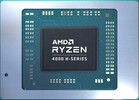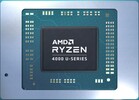AMD Ryzen 7 4800H vs AMD Ryzen 7 5800H vs AMD Ryzen 3 4300U
AMD Ryzen 7 4800H
► remove from comparison
The AMD Ryzen 7 4800H is a Renoir APU designed for larger, more powerful laptops with room for better termals. The Ryzen features eight Zen 2 cores running at 2.9 GHz (base clock speed) to 4.2 GHz (Boost). The CPU also has 8 MB of L3 cache and a Vega series integrated GPU. Thread-doubling SMT tech is enabled in this processor, allowing for up to 16 concurrent processing threads.
Architecture
Ryzen 7 4800H is manufactured on the modern 7 nm TSMC process and in part thanks to this fact AMD promises an up to 2x higher performance-per-watt figure compared to Ryzen 3000 series mobile APUs. This isn't the only noteworthy change however as Zen 2 architecture is leagues ahead of the outgoing Zen+ when it comes to single-core performance. Renoir family processors feature up to 8 CPU cores compared to 4 cores of the previous generation mobile AMD CPUs.
A 4800H will work with dual-channel DDR4-3200 or quad-channel LPDDR4-4266 RAM. The important difference between desktop Ryzen 4000 and mobile Ryzen 4000 processors is that the latter do not have PCI-Express 4.0 support, meaning those blazing-fast NVMe SSDs will be limited to a throughput of 3.9 GB/s.
The Ryzen 7 gets soldered straight to the motherboard (FP6 socket) and is thus not user-replaceable. Please go to our Renoir processor family hub for more information on these CPUs.
Performance
The average 4800H in our database is in the same league as the Core i7-11850H, the Core i7-1360P and also the Ryzen 7 PRO 6850U, as far as multi-thread benchmark scores are concerned. This highlights just how great of a job Renoir designers did, back in the day.
Thanks to its decent cooling solution and a long-term power limit of 45 W, the MSI Alpha 17 A4DEK is among the fastest laptops built around the 4800H that we know of. It can be more than 20% faster in CPU-bound workloads than the slowest system featuring the same chip in our database, as of August 2023.
Graphics
Ryzen 7 4800H features the Radeon RX Vega 7, a 7 CU integrated graphics adapter running at up to 1,600 MHz. The iGPU's underlying architecture is fairly old as of 2021, yet its 448 shaders will let you play many games of 2020 and 2021 as long as you stick to reasonable resolutions and presets. F1 2021 runs well at medium quality, 1080p resolution, to give you an example. A Vega 7 can be as fast as a GeForce GTX 1050 Max-Q, or as slow as an 80 EU Iris Xe; this depends on the benchmark as well as on cooling system performance and TDP settings of a laptop as mentioned above. As the iGPU has no VRAM of its own, it is paramount that fast system RAM is used.
The Vega definitely supports UHD 2160p monitors at 60 Hz. This iGPU is capable of hardware decoding AVC, HEVC and VP9-encoded videos. There is no AV1 support to be found here though. Such a video will have to be SW-decoded leading to much lower energy efficiency.
Power consumption
This Ryzen 7 series chip has a default TDP (also known as the long-term power limit) of 45 W. Laptop makers are allowed to change that to anything between 35 W and 54 W, with clock speeds and performance changing accordingly as a result. The Ryzen 7 4800HS is a 35 W edition of the Ryzen 7 4800H that trades away a bit of performance for lower power consumption. In both cases, an active cooling solution is a must.
Both the 4800H and the 4800HS are built with TSMC's 7 nm process for decent, as of late 2022, energy efficiency.
AMD Ryzen 7 5800H
► remove from comparison
The AMD Ryzen 7 5800H is a high-performance octa-core processor of the Cezanne product family. It was released in Q1 2021; it is designed for use in larger laptops, primarily gaming laptops and DTRs. The Ryzen features eight SMT-enabled Zen 3 cores running at 3.2 GHz (base clock speed) to 4.4 GHz (highest Boost frequency possible) along with the Vega 8 iGPU. The chip has 16 MB of L3 cache.
Architecture
The Ryzen 7 5800H is manufactured on the modern 7 nm TSMC process, just like the outgoing Ryzen 7 4800H was; both CPUs have 8 cores and 16 threads, too. The underlying microarchitecture is what makes the two vastly different as the newer Zen 3 microarchitecture brings a massive IPC improvement over Zen 2. To be specific, AMD promises an increase of up to 19%, with independent reviews pointing to a lower (but sizeable nonetheless) 12% increase.
Ryzen 5 5800H supports dual-channel DDR4-3200 and quad-channel LPDDR4-4266 RAM. Unlike the desktop-grade Ryzen 5000-series processors, Ryzen 5 5800H does not support PCI-Express 4.0, meaning NVMe SSDs will be limited to read/write rates of 3.9 GB/s.
The CPU gets soldered straight on to the motherboard (FP6 socket interface) and is thus not user-replaceable.
Performance
The Ryzen is a marvel of a processor. As far as multi-thread benchmark scores are concerned, the average 5800H in our database trades blows with the Intel Core i5-12500H, Core i7-11800H, Core i7-12650H, Core i9-11950H and also the AMD Ryzen 9 4900H. Needless to say, a system built around this CPU will have little difficulty chewing through pretty much any workload imaginable for years to come.
With the long-term CPU power limit of 75 W, the Lenovo Legion 5 15ACH is among the fastest 5800H-toting laptops that we have tested; it can be at least 20% faster in CPU-bound workloads than the slowest laptops built around the 5800H in our database such as the HP Victus 16 or the Asus ZenBook 14X OLED.
Graphics
In addition to its eight CPU cores, the APU has the Radeon RX Vega 8 graphics adapter. Just like the name suggests, Vega 8 features 8 Compute Units (8 x 64 = 512 unified shaders); in the case of Ryzen 7 5800H, the Vega runs at up to 2,000 MHz.
On paper, this iGPU is inferior to the 96 EU Intel Iris Xe Graphics G7. However, as is usually the case, synthetic benchmarks do not tell the entire story, as AMD's drivers are superior to those of Intel. As a result, the Vega will let you play a lot of games released in 2020 and 2021 at reasonable resolutions (up to Full HD 1080p) and Low to Medium presets. Mass Effect Legendary Edition is playable at 1080p (High), to give you an example. As the iGPU has no VRAM of its own, it is paramount that fast system RAM is used.
The graphics adapter definitely supports 2160p UHD monitors at 60 Hz. AVC, HEVC, MPEG-2, VP9-encoded videos can be hardware-decoded with the Vega but there is no AV1 support here; such a video will be software-decoded for much lower energy efficiency.
Power consumption
This AMD APU has a default TDP (also known as the long-term Power Limit) of 45 W that can be changed to anything between 35 W and 54 W by laptop makers, with clock speeds and performance changing accordingly as a result. No matter the exact value, an active cooling solution is a must.
The Ryzen 7 5800H is built with TSMC's 7 nm process for very decent, as of early 2022, energy efficiency.
AMD Ryzen 3 4300U
► remove from comparison
The AMD Ryzen 3 4300U is a processor for thin and light laptops based on the Renoir family. The 4300U integrates four cores based on the Zen 2 microarchitecture (quad core CPU). They are clocked at 2.7 (guaranteed base clock) to 3.7 GHz (Turbo) without SMT / Hyperthreading support (4 threads). The chip is manufactured on the modern 7 nm TSMC process and partly thanks to it AMD advertises a 2x improved performance per Watt for the Renoir chips. Compared to the faster Ryzen 5 4000 CPUs (e.g., Ryzen 5 4600U), the Ryzen 3 only offers 4 cores and lower Turbo clock speeds.
In addition to the four CPU cores, the APU also has the Radeon RX Vega 5 integrated graphics card with 5 CUs and up to 1400 MHz. The dual channel memory controller supports DDR4-3200 and energy efficient LPDDR4-4266 RAM. Furthermore, 4 MB of Level 3 cache can be found on the chip. See our hub page on the Renoir Processors for more information.
Performance
The average 4300U in our database matches the Core i5-1035G4 and the Core i5-11300H, both quad-core chips, in multi-thread performance. Technically a lower mid-range CPU, this Ryzen is light years ahead of Intel Pentiums and AMD Athlons that so many sub-US$500 laptops ship with.
Your mileage may vary depending on how high the CPU power limits are and how competent the cooling solution of our system is.
Power consumption
The Ryzen 3 series chip has a default TDP (also known as the long-term power limit) of 15 W, a value that laptop manufacturers are free to change to anything between 10 W and 25 W with performance and clock speeds changing accordingly as a result. By going for the lowest value, it is possible to build passively cooled tablets, laptops, mini-PCs around this APU.
The 7 nm TSMC process the Ryzen 3 4300U is manufactured on makes for average, as of mid 2023, energy efficiency.
| Model | AMD Ryzen 7 4800H | AMD Ryzen 7 5800H | AMD Ryzen 3 4300U | ||||||||||||||||||||||||||||||||||||||||||||||||||||
| Codename | Renoir-H (Zen 2) | Cezanne-H (Zen 3) | Renoir-U (Zen 2) | ||||||||||||||||||||||||||||||||||||||||||||||||||||
| Series | AMD Renoir (Ryzen 4000 APU) | AMD Cezanne (Zen 3, Ryzen 5000) | AMD Renoir (Ryzen 4000 APU) | ||||||||||||||||||||||||||||||||||||||||||||||||||||
| Series: Renoir (Ryzen 4000 APU) Renoir-U (Zen 2) |
|
|
| ||||||||||||||||||||||||||||||||||||||||||||||||||||
| Clock | 2900 - 4200 MHz | 3200 - 4400 MHz | 2700 - 3700 MHz | ||||||||||||||||||||||||||||||||||||||||||||||||||||
| L1 Cache | 512 KB | 512 KB | 256 KB | ||||||||||||||||||||||||||||||||||||||||||||||||||||
| L2 Cache | 4 MB | 4 MB | 2 MB | ||||||||||||||||||||||||||||||||||||||||||||||||||||
| L3 Cache | 8 MB | 16 MB | 4 MB | ||||||||||||||||||||||||||||||||||||||||||||||||||||
| Cores / Threads | 8 / 16 | 8 / 16 | 4 / 4 | ||||||||||||||||||||||||||||||||||||||||||||||||||||
| TDP | 45 Watt | 45 Watt | 15 Watt | ||||||||||||||||||||||||||||||||||||||||||||||||||||
| Technology | 7 nm | 7 nm | 7 nm | ||||||||||||||||||||||||||||||||||||||||||||||||||||
| max. Temp. | 105 °C | 105 °C | 105 °C | ||||||||||||||||||||||||||||||||||||||||||||||||||||
| Socket | FP6 | FP6 | FP6 | ||||||||||||||||||||||||||||||||||||||||||||||||||||
| Features | DDR4-3200/LPDDR4-4266 RAM, PCIe 3, MMX, SSE, SSE2, SSE3, SSSE3, SSE4A, SSE4.1, SSE4.2, AVX, AVX2, BMI2, ABM, FMA, ADX, SMEP, SMAP, SMT, CPB, AES-NI, RDRAND, RDSEED, SHA, SME | DDR4-3200/LPDDR4-4266 RAM, PCIe 3, MMX, SSE, SSE2, SSE3, SSSE3, SSE4A, SSE4.1, SSE4.2, AVX, AVX2, BMI2, ABM, FMA, ADX, SMEP, SMAP, SMT, CPB, AES-NI, RDRAND, RDSEED, SHA, SME | DDR4-3200/LPDDR4-4266 RAM, PCIe 3, MMX, SSE, SSE2, SSE3, SSSE3, SSE4A, SSE4.1, SSE4.2, AVX, AVX2, BMI2, ABM, FMA, ADX, SMEP, SMAP, CPB, AES-NI, RDRAND, RDSEED, SHA, SME | ||||||||||||||||||||||||||||||||||||||||||||||||||||
| iGPU | AMD Radeon RX Vega 7 ( - 1600 MHz) | AMD Radeon RX Vega 8 (Ryzen 4000/5000) ( - 2000 MHz) | AMD Radeon RX Vega 5 ( - 1400 MHz) | ||||||||||||||||||||||||||||||||||||||||||||||||||||
| Architecture | x86 | x86 | x86 | ||||||||||||||||||||||||||||||||||||||||||||||||||||
| Announced | |||||||||||||||||||||||||||||||||||||||||||||||||||||||
| Manufacturer | www.amd.com | www.amd.com | www.amd.com |
Benchmarks
Average Benchmarks AMD Ryzen 7 4800H → 100% n=35
Average Benchmarks AMD Ryzen 7 5800H → 114% n=35
Average Benchmarks AMD Ryzen 3 4300U → 59% n=35
* Smaller numbers mean a higher performance
1 This benchmark is not used for the average calculation













